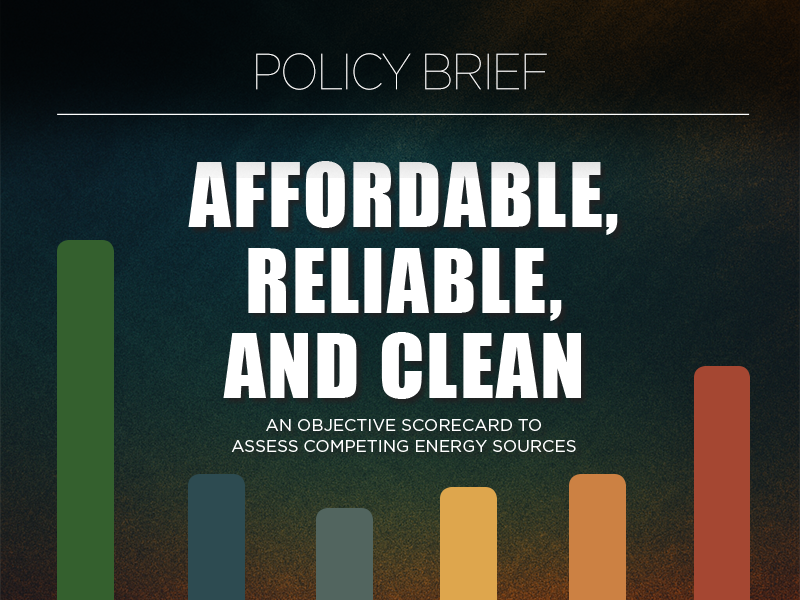Editor’s Note: Due to other pressing work for Heartland, this week’s CCW is a bit short. Thanks for your understanding.
IN THIS ISSUE:
- Earth Is Greening: Thank Climate Change
- Defense Department Scraps Unjustified Climate Programs

Earth Is Greening: Thank Climate Change
New research published in the journal Remote Sensing of the Environment confirms, yet again, what regular readers of Climate Change Weekly and Heartland’s other climate change products have long known: the Earth is greening in general, and increased carbon dioxide levels and better moisture conditions are responsible.
The study, from a team of 17 researchers at various universities and research facilities in the United States and China, reports that in 2020 the Earth’s “greenness”—its vegetation coverage and mass—reached its highest levels since the early 2000s and probably longer.
Using remote sensing devices and indicators supplemented by machine learning, the researchers determined the greening was “largely linked to continuous growth in boreal and temperate vegetation” and “[c]omplemented by a transient tropical vegetation boost due to increased rainfall.”
Although the study has been largely ignored by the mainstream media (surprise, surprise—NOT!), the Daily Sceptic covered it, reporting,
The work helps confirm other recent scientific work that points to massive global plant growth directly related to recent increases in natural and human-caused carbon dioxide. Plants have evolved to grow in an atmosphere much richer in CO2 than current near-denuded levels, and the recent growth and its myriad benefits for humankind should not be surprising. . . .
This is not the first time that an acceleration in global greening over the last two decades has been observed. Last year a group of Chinese scientists found that about 55% of global land mass had shown an “accelerated rate” of vegetation growth. The Chinese team that included the Eco-Climatologist Professor Tiexi Chen stated that “global greening is an indisputable fact.”
Aside from the greening of existing temperate and tropical forests and vegetation, there has also been marked de-desertification as desert edges are shrinking, being reclaimed by vegetation, and oases are expanding.
Various studies show that the CO2 fertilization effect is helping pollinators and is responsible for a large decline in global hunger in recent decades as the higher CO2 bears a large portion of the credit for increasing crop yields.
The authors conclude that their results suggest “a robust resilience and adaptability of global vegetation in the face of changing environmental [conditions].”
As I mentioned above, the beneficial CO2-induced greening of the Earth, with longer growing seasons and improved rainfall and plant efficiency, is not news to my readers. Climate Realism has published nearly 60 stories citing different research papers and studies that document CO2-induced greening, and hundreds more examining how greening has improved crop yields and production and reduced starvation, hunger, and malnutrition.
In addition, Heartland discussed global greening with award-winning physicist Will Happer during the 78th episode of the Climate Realism show, and we have discussed global greening and its continuing agricultural boost on a number of panels at Heartland’s series of 15 International Conferences on Climate Change.
Various analyses of the so-called “Social Cost of Carbon” calculations indicate global greening and its effects on agriculture alone may mean that the metric would be better labeled the Social Net Benefit of Carbon.
Global greening is an established fact, and this study is just one more data point of proof.
Sources: Remote Sensing of Environment; Daily Sceptic; Climate Realism; The Heartland Institute; Climate Change Weekly

Defense Department Scraps Unjustified Climate Programs
Under President Donald Trump, the U.S. Defense Department (DOD) and the branches of the military it manages are shutting down their costly, inane climate change efforts, which tended to undermine military preparedness without affecting climate change.
Efforts were already underway to shutter DOD climate justice and other climate-related programs unrelated to military readiness when Defense Secretary Pete Hegseth posted on X in early March, “The @DeptofDefense does not do climate change crap. We do training and warfighting,” in response to a reporter’s question about the programs.
Across its various service branches, the DOD is probably the largest user of fossil fuels in the world, with one estimate being that the department uses 4.6 billion gallons of fuel each year. A breakdown of greenhouse gas emissions of the various service branches in 2021 estimated 56 percent were by the U.S. Air Force, Naval operations accounted for 31 percent, and the Army and Marine Corps emitted 9 percent and 5 percent, respectively. At that time, emissions from the U.S. Space Force were not calculated or included in the total.
In truth, Zero Emissions for DOD operations was an insane pipedream. In practical terms, it was and is dangerous to military readiness and function, and if operationalized it would leave U.S. national security to the machinations of any enemy military still using equipment reliant on fossil fuels.
President Donald Trump, Secretary Hegseth, and the current joint chiefs recognize that and have begun to remedy the security vulnerabilities Biden, and Obama before him, created through their climate obsession.
On April 22, Earth Day no less, the Navy officially announced it was scrapping the Biden-era “climate action plan.” Navy Secretary John Phelan announced in a video, “Today, I’m focusing on the warfighters first, and I’m rescinding the Biden administration’s climate action program. Our focus needs to be on lethality and our warfighters.”
Biden set climate-oriented performance goals for the U.S. Navy to reduce the services’ greenhouse gas emissions and remove existing CO2 from the atmosphere to make the Navy’s operations net-zero or below by 2050.
The Navy began implementing initiatives to meet that overall goal, committing to purchase only 100 percent zero-emission vehicles by 2035, with a midterm goal of 100 percent zero-emission light-duty vehicles by 2027, and cutting emissions at its installations by 50 percent by 2032.
Concerning sailing vessels, the Navy under President Obama wasted more than $57 billion by 2017 on making the “Great Green Fleet,” an effort to produce enough biofuels to power its ships and boats. The biofuel portion of the fleets’ fuel cost about $14 per gallon, seven times the cost of diesel.
“The program also faced logistical challenges, as biofuels were not widely available in overseas ports, necessitating the continued use of traditional diesel fuel,” reported Willow Tohi for Natural News. At the time of Biden VP Kamala Harris’s election loss, 99 percent of the Navy’s fleet still ran on fossil fuels, despite this huge investment.
The Air Force had a similarly wasteful and unsuccessful “Sustainable Aviation Fuel” program to produce jet fuels from biofuels and develop hydrogen-powered aircraft. In 2023 the Air Force contracted with startup company Jet Zero, providing it with $235 million to produce jets that use 50 percent less fuel per passenger mile by 2027 than current jets do. The long-term goal was for the Air Force to purchase 100 to 200 such jets, once the technology was proven, to reduce operational emissions. Under Trump, the future of this program and other Air Force green fuel and technology programs is in doubt.
While the Air Force certified some of its jets to run on a mix of traditional jet fuels and biofuels in 2021, at present Air Force flight operations are almost entirely fueled by traditional jet fuel, kerosene-based Jet Propellant-8, despite billions of dollars in contracts and investments.
As for efforts to build electric-powered aircraft, the battery weight and limited range make it infeasible with any technologies likely to become available in the near term.
Concerning the Army’s efforts to go net zero, energy and climate analyst and author Steve Gorham writes in a Master Resource post,
The “Army Climate Strategy” plan of February 2022 called for the near-term use of microgrids and renewable electricity at military bases. It called for a 100% transition of the “non-tactical vehicle fleet” to electric vehicles (EVs) by FY 2027. Spending would amount to about $2 billion per year from 2023 to 2027.
The plan also proposed to begin a transition of light, medium, and even heavy battlefield tactical vehicles to electric drive by 2027, and the development of “battlefield chargers” for these vehicles. Charging electric tanks on the battlefield is another example of “climate change crap” with no military value.
The Army’s plan to electrify tactical vehicles by 2027 was impractical for domestic operations and training, much less for international battlefield conditions. No milestones toward the Army’s goals have been met so far.
The DOD’s new management is installing policies that make efficient, effective operational capabilities in defense of the nation priorities one, two, and three. Any other goals—such as nation building or humanitarian missions—are being deemphasized. Others, such as fighting climate change, are seemingly being jettisoned entirely, and rightly so.
“While adaptation measures such as building sea walls and erecting flood barriers are sensible for building resilience to weather events, they are not tied to measurable climate change mitigation,” Tohi writes. “These efforts are pragmatic but do not align with the broader, often ideological, climate change agenda.
“Secretary Hegseth’s decision to redirect these funds to strengthening the U.S. military marks a new era of realistic policy,” concludes Tohi.
I wholeheartedly agree with that sentiment. Climate change and any problems stemming from it do not threaten military readiness or effectiveness, but efforts to fight climate change do.
Sources: Natural News; E&E News; The Master Resource; The Federalist





